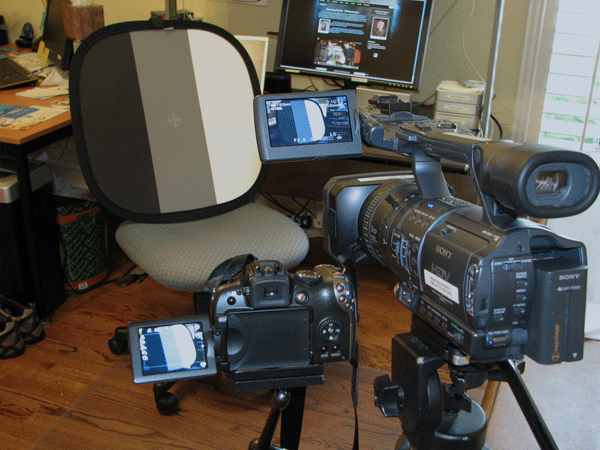Color Calibration in the Field
How do you get all the different cameras you might use to cover an event to match? There is a trick you can use to set up a color profile for each of the cameras, and then use the corrections established there to correct for the rest of the footage from your project.
With anything and everything being able to shoot HD these days, there is so much more we can do, creatively, with all the new cameras available to us. Tiny little point-and-shoot cameras can shoot 720p30 HD in an AVCHD codec for an entire event, and be tucked anywhere out of sight, capturing that extra little camera angle that couldn't be caught otherwise. Operators can be "embedded" in the crowd and seen with the main cameras, yet never draw attention to themselves because they aren't holding big pro-gear rigs.
But how do you get all the different cameras you might use to cover an event to match? Compared to the beautiful 3-chip footage that I get from my first camera, with the footage I shoot with lesser models to round out my footage, the depth isn't there, the colorimetry, and so forth. Not only does it look not as good, it clearly doesn't match and draws attention to itself.
But in trying to find ways to make the footage work, and get the colorimetry of the different cameras closer together to lessen the visible change, I came to the realization that, if we plan on using these cameras from the outset, there is a trick that can be used to set up a color profile for each of the camcorders, and then use the corrections established there to correct for the rest of the footage from your project.
Now, this doesn't work with every camera, or in every situation. Cameras that continually shift their colorimetry, white balance, and so on, will not work with this color correction methodology. But with most cameras, a simple tool gets you almost all the way, and your eye can determine the rest.
The Tool: Digital Target
The tool I am using is the 24in Digital Target from PhotoVisionVideo.com. This single target can be used as a reflector, but the magic lies in the black/gray/white strips on the other side of the reflector. In fact, I didn't get this to be used as a reflector at all; that's just a bonus. I got it specifically for color-matching disparate cameras.
The PhotoVision website is chock full of videos and samples. The videos are targeted to still photographers. However, the principles for video and still cameras are the same. You need to be able to set a manual white balance. You need to set a custom white balance--and it actually doesn't matter what custom white balance, but it needs to be set to one thing so that the white balance doesn't change throughout the shot-especially in events where you're delivering instantly or quick-turn and don't have time to match in post. That said, if you camera can't be set to a manual white balance, then this target and this article can't help you.
Automatic white balance is a moving target. If the camera thinks the white point has gone "cool" it will warm the image up automatically. If the camera thinks the image has gone warm (more yellow) it will cool down (more blue) the image accordingly. Also, when things change within the shot, the camera can dramatically change the white point of the image when it attempts to compensate. This will break the calibration process we build here.
Once you have a manual white balance set on all your cameras, you need to put the target in front of all your cameras--under the same light. This means that you don't move the target around from room to room; you don't even rotate it inside a room or outside. It has to be sitting still. All the cameras have to record the target from about the same position, because reflected light will appear different depending on the angle. So you can't shoot the target from way off to the right and way off to the left and expect those shots to match-they won't.
Once you have all your cameras roll some footage of the target, then they are free to go roam around, but they cannot change their white balance or colorimetry thereafter (no picture profiles, or other settings that change color at all). You can't rebalance your color because if you do, you'll throw away the profile you created by recording the calibration target with each of the cameras.
This doesn't mean you can't ever change your white balance or settings ever again. You can. But you'll need to recalibrate the footage with the calibration target every time you need to make a change in any of the cameras. And you can't just recalibrate one camera; you have to recalibrate all the cameras, so you have a new set of calibration profiles for the new lighting situation in which you'll be shooting.
You can see the setting for my "test" interview in Figure 1 (below). There's sky light coming in from a window on camera right, a little bit of daylight coming in from camera left, tungsten and fluorescent light coming from a ceiling light. What white balance would that be? And how would you set up two cameras to match? The answer: Fix it in post.

Figure 1. An HDV camera and a video-capable still camera ready for color-matching with the 24in Digital Target from PhotoVisionVideo.com for my test interview setup